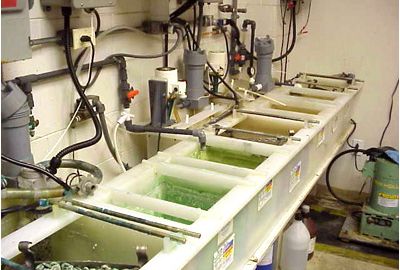Metal Plating

Metal plating is the surface coating of an object i.e., jewelry, with a thin layer of metal 0.5-2.5 microns thick. (1 micron is a millimeter of a millimeter).
In jewelry, the most common plating are gold plating, silver plating, platinum plating, rhodium plating and others.
The plating process is based on Galvanism (by Luigi Galvani) the process of electrolytic transfer of positive metal ions to the jewelry to be coated. This is done to protect the jewelry, to improve its appearance, or to create a new aesthetic effect.
Modern plating techniques, use technology in a dynamic way. IVD and PVD plating today. use nanotechnology in a vacuum environment.
Metal plating for silver jewellery
Gold plating.Electrochemical deposition of gold at least 0.5 micro thick on a metal object. The Italian chemist Luigi Valentino Brugnatelli, in 1805, was the first who gold-plated a small silver surface. The first professional gold and silver-plating workshops began in the late 19th century. Pure gold gives protection from oxidation, keeps the shine of the jewelry, but mainly gives a different aesthetic result, a beautiful color of golden luxury.
Rose gold plating. Gold plating with 14 carat gold, (a gold alloy with pure copper). Copper gives gold a strong pink hue, a very popular modern color in jewelry.
Silverplating. The deposition of silver on the jewelry or object, to give the object a silver look and shine. One of the oldest methods of jewelry metal-plating, today it is slowly being withdrawn due to the dynamic entry of rhodium plating.
Rhodium plating. Rhodium is an extremely rare noble metal of the platinum family. With silver-white color, it is a chemically inert metal, resistant to corrosion and stress, due to its high hardness. The 0.7-1.0 micro layer, with rhodium or with an alloy of rhodium and platinum, protects the jewelry and gives them shine and an elegant dynamic platinum color.
Black rhodium plating. Into the rhodium alloy with platinum, we add black trivalent color supplements that create a matte black artistic surface, for an attractive piece of jewelry.
Black Ruthenium plating. Ruthenium is a noble metal of the platinum and rhodium families. Combined with titanium nitrides and special additives that give it color, it protects jewelry from stress and corrosion, with a special black shade, unprecedented in the world history of jewelry.
Metal plating for stainless steel jewellery
PVD plating. PVD (Physical Vapor Deposition). The methods that were born in the 70's in NASA laboratories, passed the 21st century in everyday life in technology of plating products of high demands. The procedure is performed in vacuum chambers. The surface of the coated jewel, is "bombarded" with titanium nitride vapors and then, covered with many thin layers of the coating material for greater adhesion and durability.
The final result is a jewelry very resistant to corrosion, oxidation and knocks. PVD technology is 6-8 times more durable than conventional plating.
The method does not produce heavy metal residues or contaminated waste, overall, it is friendly for the environment, but also to the human body.
IP plating. A special PVD process, when thin films of electrically charged atoms (ions) of the plating material, cover the surface we want to plate. The result is a shiny piece of jewelry that is completely faithful to every detail of the design, extremely durable, a piece of jewelry that satisfies the demanding consumer of the mod
 Ελληνικά
Ελληνικά  English
English